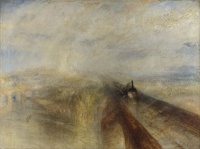Steam
From The Art and Popular Culture Encyclopedia
|
He has an arm, an iron arm Destroy King Steam, the Moloch wild, --King Steam (1812) |
|
Related e |
|
Featured: |
Steam is the technical term for water vapor, the gaseous phase of water, which is formed when water boils. Technically speaking, in terms of the chemistry and physics, steam is invisible and cannot be seen; however, in common language it is often used to refer to the visible mist of water droplets formed as this water vapor condenses in the presence of (cooler) air. At lower pressures, such as in the upper atmosphere or at the top of high mountains water boils at a lower temperature than the nominal Template:Convert at standard temperature and pressure. If heated further it becomes superheated steam.
The enthalpy of vaporization is the energy required to turn water into the gaseous form when it increases in volume by 1,600 times at standard temperature and pressure; this change in volume can be converted into mechanical work by steam engines and steam turbines. Steam engines played a central role to the Industrial Revolution and modern steam turbines are used to generate electricity. If liquid water comes in contact with a very hot substance (such as lava, or molten metal) it can create a steam explosion. Steam explosions have been responsible for many foundry accidents, and may also have been responsible for much of the damage to the plant in the Chernobyl accident.
See also
- Electrification
- Food steamer or steam cooker
- Geyser—geothermally-generated steam
- IAPWS—an association that maintains international-standard correlations for the thermodynamic properties of steam, including IAPWS-IF97 (for use in industrial simulation and modelling) and IAPWS-95 (a general purpose and scientific correlation).
- Industrial Revolution
- Live steam
- Mass production
- Nuclear power—and power plants use steam to generate electricity
- Oxyhydrogen
- Psychrometrics—moist air/vapor mixtures, humidity and air conditioning
- Steam locomotive


